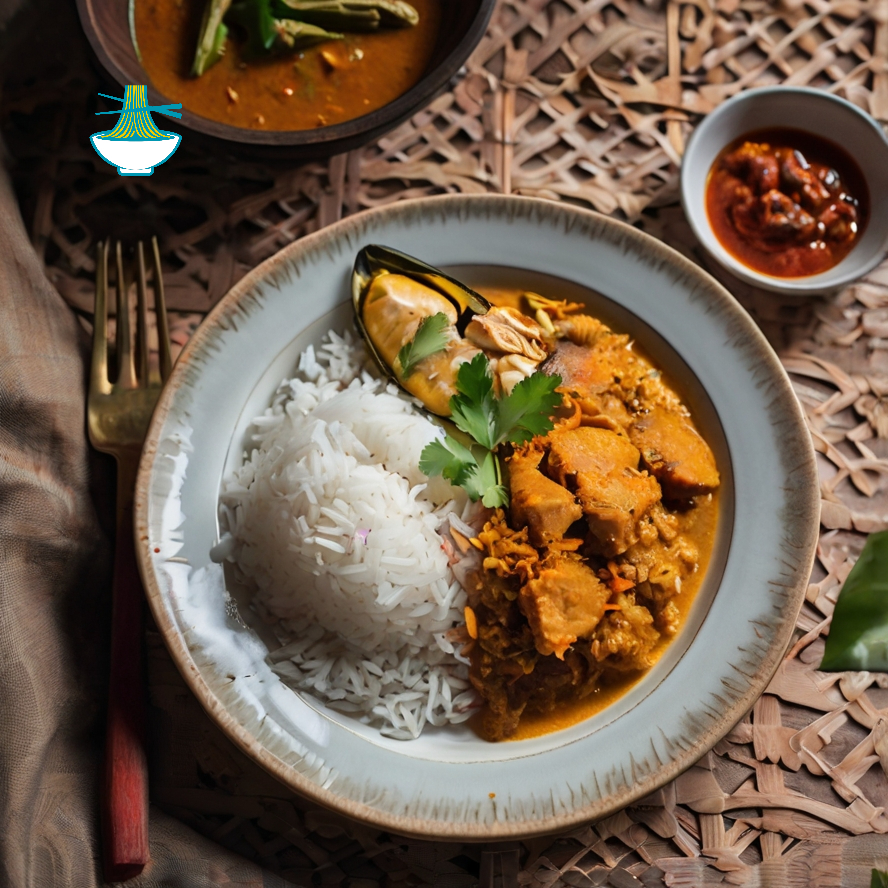Discover the authentic flavors of Nasi Dagang, a beloved Malaysian dish featuring fragrant rice paired with a rich fish curry, spicy sambal, and tangy pickled vegetables. This traditional recipe will guide you through preparing each component for a delicious and satisfying meal.
Ingredients:
For the Rice:
- 2 cups jasmine rice
- 1 cup glutinous rice
- 1 1/2 cups coconut milk
- 2 pandan leaves, tied into a knot
- 1 teaspoon salt
For the Fish Curry:
- 500g mackerel or other firm white fish, cut into pieces
- 2 tablespoons curry powder
- 1 tablespoon turmeric powder
- 1 onion, finely chopped
- 3 cloves garlic, minced
- 1 thumb-sized piece of ginger, minced
- 1 cup coconut milk
- 2 tablespoons tamarind paste
- 2 tablespoons vegetable oil
- Salt and sugar to taste
For the Sambal:
- 5 red chilies, seeded and chopped
- 2 cloves garlic
- 1 small onion
- 1 tablespoon shrimp paste (belacan)
- 2 tablespoons vegetable oil
- 1 tablespoon sugar
- 1 tablespoon tamarind paste
- Salt to taste
For the Pickled Vegetables:
- 1 carrot, thinly sliced
- 1 cucumber, thinly sliced
- 1/4 cup rice vinegar
- 2 tablespoons sugar
- 1/2 teaspoon salt
Instructions:
Prepare the Rice:
- Rinse jasmine and glutinous rice until the water runs clear.
- Combine rice, coconut milk, pandan leaves, and salt in a rice cooker. Cook according to the rice cooker's instructions. Alternatively, steam the mixture in a heatproof bowl over boiling water for about 30 minutes.
Make the Fish Curry:
- Heat vegetable oil in a pan over medium heat. Sauté onions, garlic, and ginger until fragrant.
- Add curry powder and turmeric powder, cooking for 1-2 minutes.
- Stir in coconut milk and tamarind paste. Bring to a simmer.
- Add fish pieces and cook until the fish is cooked through and the sauce thickens. Season with salt and sugar to taste.
Prepare the Sambal:
- Blend red chilies, garlic, onion, and shrimp paste into a smooth paste.
- Heat vegetable oil in a pan and fry the paste until aromatic.
- Add sugar, tamarind paste, and salt, and cook for a few more minutes until the sambal thickens.
Pickle the Vegetables:
- Combine rice vinegar, sugar, and salt in a bowl, stirring until dissolved.
- Add the carrot and cucumber slices to the mixture and let them pickle for at least 30 minutes.
Serve:
- Serve the fragrant rice with a side of fish curry, sambal, and pickled vegetables. Enjoy the delightful combination of flavors and textures!
Feel free to adjust the spiciness and seasoning according to your taste preferences.
Nutritional Values
Rice (Jasmine and Glutinous Rice)
- Calories: 130-150 kcal
- Carbohydrates: 28-30g
- Protein: 2-3g
- Fat: 0.2-0.5g
- Fiber: 0.5-1g
Benefits:
- Energy Source: High in carbohydrates, providing quick and sustained energy.
- Digestive Health: Contains some fiber, which aids in digestion.
Coconut Milk
- Calories: 230 kcal
- Carbohydrates: 6g
- Protein: 2g
- Fat: 24g (saturated fat)
- Fiber: 2g
Benefits:
- Healthy Fats: Rich in medium-chain triglycerides (MCTs), which can be easily converted into energy.
- Minerals: Good source of manganese, copper, and iron.
Pandan Leaves
- Calories: 26 kcal
- Carbohydrates: 6g
- Protein: 1g
- Fat: 0.2g
- Fiber: 3g
Benefits:
- Antioxidants: Contains compounds with antioxidant properties.
- Aromatic Qualities: Adds a unique fragrance to dishes.
Fish (Mackerel)
- Calories: 305 kcal
- Carbohydrates: 0g
- Protein: 25g
- Fat: 22g (high in omega-3 fatty acids)
- Fiber: 0g
Benefits:
- Omega-3 Fatty Acids: Supports heart health and reduces inflammation.
- Protein: High-quality protein source essential for muscle growth and repair.
Onion
- Calories: 40 kcal
- Carbohydrates: 9g
- Protein: 1g
- Fat: 0.1g
- Fiber: 1.7g
Benefits:
- Antioxidants: Contains quercetin, which has anti-inflammatory and antioxidant properties.
- Immune Support: Helps in maintaining a healthy immune system.
Garlic
- Calories: 149 kcal
- Carbohydrates: 33g
- Protein: 6g
- Fat: 0.5g
- Fiber: 2.1g
Benefits:
- Antimicrobial: Known for its antibacterial and antiviral properties.
- Heart Health: May help reduce blood pressure and cholesterol levels.
Ginger
- Calories: 80 kcal
- Carbohydrates: 18g
- Protein: 2g
- Fat: 0.7g
- Fiber: 2g
Benefits:
- Anti-Inflammatory: Contains gingerol, which has anti-inflammatory and antioxidant effects.
- Digestive Aid: Helps in digestion and may reduce nausea.
Chilies
- Calories: 40 kcal
- Carbohydrates: 9g
- Protein: 2g
- Fat: 0.4g
- Fiber: 1.5g
Benefits:
- Capsaicin: May boost metabolism and reduce pain.
- Vitamins: High in vitamin C and antioxidants.
Shrimp Paste (Belacan)
- Calories: 150 kcal
- Carbohydrates: 2g
- Protein: 30g
- Fat: 3g
- Fiber: 0g
Benefits:
- Protein: Rich in protein, providing essential amino acids.
- Flavor Enhancer: Adds depth and umami to dishes.
Vinegar
- Calories: 22 kcal
- Carbohydrates: 0g
- Protein: 0g
- Fat: 0g
- Fiber: 0g
Benefits:
- Digestive Aid: May improve digestion and blood sugar control.
- Preservation: Acts as a natural preservative.
Carrot
- Calories: 41 kcal
- Carbohydrates: 10g
- Protein: 0.9g
- Fat: 0.2g
- Fiber: 2.8g
Benefits:
- Vitamin A: High in beta-carotene, which supports vision and immune health.
- Antioxidants: Contains antioxidants that may reduce the risk of chronic diseases.
Cucumber
- Calories: 16 kcal
- Carbohydrates: 4g
- Protein: 0.7g
- Fat: 0.1g
- Fiber: 1g
Benefits:
- Hydration: High water content helps in maintaining hydration.
- Low Calories: Low in calories, making it ideal for weight management.
These ingredients offer a variety of nutrients and health benefits, making Nasi Dagang not only a delicious dish but also a nutritious one.


Comments